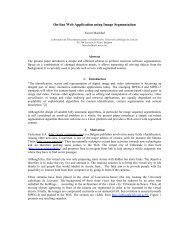motion estimation and compensation for very low bitrate video coding
motion estimation and compensation for very low bitrate video coding
motion estimation and compensation for very low bitrate video coding
You also want an ePaper? Increase the reach of your titles
YUMPU automatically turns print PDFs into web optimized ePapers that Google loves.
B.3 Rate Distortion Function 177<br />
B.3 Rate Distortion Function<br />
The Rate Distortion function R(D) (cf. gure B.2) speci es the minimum<br />
rate that enables one to reproduce the source with an average<br />
distortion that does not exceed D. To design the R(D) of a d.m.s. with<br />
respect to a single-letter delity criterion F , one needs to know the<br />
average distortion d(q) associated with the transition probabilities<br />
q(kjj) of the channel:<br />
d(q)= X<br />
p(j)q(kjj) (j; k): (B.22)<br />
j;k<br />
The channel de ned by q(kjj) is called D-admissible if <strong>and</strong> only if<br />
d(q) D. QD denotes the set of all D-admissible transition probability<br />
assignments: QD = fq(kjj)jd(q) Dg. In parallel, e<strong>very</strong> assignment<br />
gives rise to an average mutual in<strong>for</strong>mation:<br />
H(q) = X<br />
j;k<br />
p(j)q(kjj) log q(kjj)<br />
: (B.23)<br />
q(k)<br />
The rate distortion function R(D) offXt;pg with respect to F is then<br />
de ned by:<br />
R(D) = min H(q); (B.24)<br />
q2QD<br />
with D 2 [0; 1). Since the source is given <strong>and</strong> not the channel, such<br />
an equation determines the minimum rate at which the in<strong>for</strong>mation<br />
about the source must be conveyed to the user in order to achieve a<br />
prescribed delity (the reverse - given channel - generates a distortion<br />
rate function). It means that R(D) C is a necessary condition <strong>for</strong><br />
the existence of a communication system that operates with<br />
delity D.<br />
As illustrated on gure B.2, R(D) is a monotonic, decreasing, convex U<br />
function in the interval of interest from D =0toD = Dmax. R(D) =0<br />
<strong>for</strong> D = Dmax. Dmax is the average distortion achieved when only the<br />
statistics of the source are known but when nothing at all about the<br />
particular realization of the source has been transmitted. In this case,<br />
the decoder can only guess what the source could have been.





